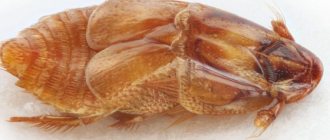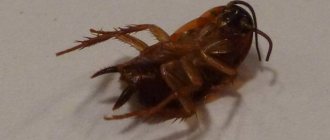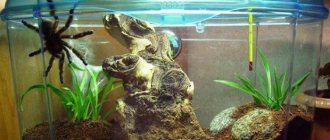Signs you need cleaning
You can understand that your pet needs ear cleaning after an examination. To do this, the ear is carefully turned inside out and examined.
It should be borne in mind that the cat may not like this, so you need to accustom him to the procedure from a young age.
If there is a lot of dirt in your ears, then you just need to clean them. But in some cases it is better not to self-medicate, but to immediately contact a veterinarian:
- Black plaque. It may indicate infection with ear mites, and may also be a sign of otitis media or other serious diseases. If left untreated, there is a high risk of deafness. After diagnosis, the doctor will prescribe ear drops depending on the form. Treatment must be carried out every day.
- Atypical formations. Consultation is necessary to determine the diagnosis. Most often, the course of treatment lasts from 15 to 20 days, then a re-examination by a specialist is required.
Other indications for ear cleaning:
- Large amount of sulfur. Ear cleaning is carried out as it accumulates, the frequency depends on the individual characteristics of the cat and breed.
- Exhibition. When attending various competitions, the cat must be clean, as the judges pay attention to such moments.
- Lack of wool. There is a risk of proliferation of pathogenic microflora, since there is no natural barrier protecting against dirt. Typical for hairless cats.
- After swimming. Remove residual moisture from the ear, this helps prevent the development of otitis media.
Features of caring for fold-eared cats
Fold cat ears are cleaned in the same way as any other pet. The nuance is that such breeds are not able to wash the “locators” themselves due to the unusual structure of the auricle. More frequent inspection and close attention will be required.
Proceed as usual. To begin, turn the ear outward (as it should be when properly cleaning a cat’s ears) and use a flashlight to illuminate the ear canal. Be careful - cats' cartilage is very delicate. If you notice plaque and dirt, remove it as you would a regular cat.
After the procedure, you will have to thoroughly dry the folded ear, because excess moisture can lead to diaper rash and the rapid formation of diseases.
What to use when cleaning
All items for cleaning ears must be prepared in advance:
- Cotton buds. Factory products with limiters are used.
- Cotton pads.
- Special lotions. Can be found in veterinary pharmacies (Beaphar, Excel Ear Cleansing). In the absence of special solutions, they can be washed with Chlorhexidine, Miramistin, and hydrogen peroxide. Oil is often used to remove wax plugs, but it is better not to use this remedy.
- Flashlight. For a better overview, you can use a head-mounted one so that both hands are free.
- Towel or sheet. Not all cats tolerate such procedures calmly; they begin to break free and are not allowed to be cleaned; they are usually restrained additionally.
It is important to choose treatment products carefully; for example, when using Frontline, which contains alcohol, cats often drool.
When to contact a veterinarian
If during examination you find pus, crusts, or bumps, then you need to see a veterinarian, as this indicates the development of a specific disease.
In addition, you need to visit a veterinarian if you regularly do preventive cleaning, but do not observe the desired effect. Sulfur, impurities constantly accumulate, an unpleasant odor has appeared, during the procedure there are purulent traces on the cotton pad, or the cat is restless, shaking its head, or itching. These symptoms are a sign of a serious illness.
Ear cleaning at the vet
How to properly clean a cat's ears
Processing must be consistent and correct:
- In order not to injure the pet or get scratches, it is fixed. To do this, use a sheet or blanket. They wrap the limbs and body of the animal, except for the head.
- Then carefully turn the ears out and inspect for dirt. If they are absent, the cat is released.
- If small dirty areas are found, wipe them with a dry cotton pad.
- If there is a lot of plaque, the ears are treated with a special lotion. Move from the inside out to prevent dirt from remaining in the ear canal. If necessary, dirty cotton swabs are replaced with clean ones until the entire surface is cleaned.
- Then, using cotton swabs soaked in a special product, carefully treat the bends and folds. It is not recommended to insert them deeply, as this can damage the eardrum.
- If wax plugs are detected, special ear drops (Otifri) are used to help loosen them. When instilling, massage the animal’s ear so that the product gets into the passage and is evenly distributed.
- After the procedure is completed, the cat is released and praised. Give a treat that improves the pet's mood.
Why does dirt appear in a cat's ears?
The auricle has a complex shape. Sulfur secretions, which are present normally, perform a protective function for the middle ear. But if they are present in excess quantities, they can become a favorable environment for the development of pathogenic microorganisms.
Dust particles, small hairs, dirt constantly get into the ears, and flakes of dying skin also accumulate. In response to this, a protective substance is produced - sulfur, which creates an obstacle to the penetration of contaminants.
Without proper care, wax plugs may form or inflammation may develop, which in special cases will lead to complete or partial hearing loss, as well as changes in the functioning of the vestibular apparatus. And hearing for them is the most important factor, because the sensitivity of a pet’s ear is several times higher than that of a human.
Required accessories
Mr. Cat warns: watch out for ear mites
The ear mite is a microscopic arthropod parasite that lives in the ear canal, whose diet includes epithelial cells. Identified by a dark brown coating on the inner surface of the ear. And also for the following reasons:
- The cat behaves differently than usual, is worried, often shakes its head, scratches its ears until it bleeds, and rubs against the furniture.
- An unpleasant odor emanates from the animal’s ears and dark crusts form.
- The cat's hearing is impaired and it does not immediately respond to calls.
If dark spots are found throughout the inner surface, you should treat them with lotion with silver ions (Cliny, Veda), which will remove plaque. Then drip with a special product (Tsipam, Decor-2, Otidez, Bars). Carry out the procedure according to the instructions for the drug until complete cure (2-3 weeks).
Step-by-step instruction
If your pet strongly resists, categorically refuses to undergo cleaning, breaking free from your hands, then it is better to secure it with a towel.
Stages of implementation:
- Warm the lotion in your hands before starting so that the cold drops do not cause discomfort.
- Shake the bottle vigorously for 10-15 seconds.
- Open the bottle and drop 2-3 drops of the product into the passage, tilting the animal's head to the side.
- Using circular movements, massage the base of the ear to distribute the liquid over the entire surface.
- Release your head so Fluffy can shake it. This will allow the dirt to come off better.
- Soak a cotton pad or swab in lotion and wipe the inside surface with it, paying attention to each fold.
- If the ear is completely cleared, then proceed to the second one.
Of course, it is better to entrust the entire process to a veterinarian, but this is not always possible. If there is a lot of dirt, then home cleaning will not be enough.
Cleaning with a cotton pad
The most common ear problems
In addition to ear mites, pets often encounter other diseases that require treatment, and if left untreated, lead to serious complications.
Otitis
Otitis is a disease in which the ear canal is affected by bacteria or yeast.
It is characterized by the following symptoms:
- purulent discharge with an unpleasant odor can be observed from the ears;
- the cat shakes its head intensely;
- the mucous membranes of the ears turn red and swell;
- The pet constantly scratches itself and meows.
Therapy is prescribed by a veterinarian after examination. Self-medication can cause complications and lead to inflammation or deafness.
Hematomas
Formed due to ruptures of blood vessels.
Reasons: The cat often shakes its head or scratches its ears. They can be identified by small burgundy spots between the auricle and the skin.
Solar dermatitis
Albinos, hairless cats and pets with white ears are susceptible to this disease. Solar dermatitis can be identified by redness of the skin and hair loss at the edges.
If you don't take action, the itching may cause your cat or cat to scratch its ears and cause an infection. There is a risk of tumors.
Squamous cell carcinoma
This neoplasm is a consequence of solar dermatitis. It affects various areas of the skin, but most often develops on cat ears. The main symptoms include red spots, lumps and hair loss. There may be ulcers that do not heal for a long time.
Frostbite
Due to hypothermia, there is a risk that the ear tissue will collapse. It can be identified by changes in skin color, first it loses color and then turns red. At the last stage it turns black and begins to peel off.
Restless behavior is caused by otitis media, ear mites, fleas or allergies. Only an established cause will help solve the problem.
To make an accurate diagnosis and correctly prescribed treatment, it is necessary to consult a specialist.
External examination of the patient
Cleaning or rinsing the ears is an unpleasant procedure for a cat. If a small animal has not been taught to trust its owner, he usually:
- turns away his muzzle;
- tries to push the person’s hand away with his paw;
- scratch, or even bite.
To clean the ears, sit the cat on the floor, chair or examination table with its back to itself, talk calmly, stroking its head. Then with one hand they fix the animal on its back, and with the other they stroke the ear between the thumb and forefinger, carefully pulling the auricle towards the back of the head. Due to this, the bending of the entrance to the external auditory canal is reduced.
Advice: when an ear examination is planned for a wild adult cat, it is better to give the animal some soothing tea beforehand.
Some cat ear problems are visible to the naked eye. So, with ear scabies (otodectosis), the cat shakes its head and scratches its ears with its paws:
- exudate leaks from the ear;
- the surface of the ear canal becomes covered with crusts;
- hairs near the ear stick together;
- Hematomas can form outside and inside.
If a cat has been in the cold for a long time, the ear can get frostbite: it becomes cold to the touch, and the pulse cannot be felt. In severe cases, blisters form. Exudate crusts and blisters also appear due to burns (contact with hot objects, open fire, hot liquid).
In addition, you can notice certain areas that are not covered with hair. This may be ringworm, dermatitis (including demodicosis), hereditary dermatosis (pigment incontinence). Wounds, ulcers and cuts are possible on a cat's ears. In all difficult cases, it is worth visiting a veterinarian.
Structure of a cat's ear
A cat's ears resemble human ears in structure and include:
- external, consisting of a funnel-shaped shell covered with wool with guard hairs inside and the auditory canal;
- in the middle there is an eardrum and a bone cavity with three bones, important in the perception of noise;
- internal - the most complex section, in which the vestibular apparatus and sound receptors are located.
In animals, the auditory canal, unlike the short human one, is curved and forms an angle. Improper cleaning can lead to wax buildup and blockage of the passage.
Cats can hear sound vibrations in the range of 20–100,000 Hz. Muscles and cartilage are able to rotate the shell to pinpoint the source of sound vibrations during hunting.
Drawing - diagram of the structure of a cat's ear
Errors
Inexperienced owners can make a number of mistakes. Cats themselves do not like encroachments into their comfort zone, and if this is done rudely, it can provoke panic in the pet. Animals have associative thinking and one unsuccessful attempt is enough for the procedure to forever turn into a terrible event.
Is it possible and how to rinse a cat’s nose with saline solution?
Careless use of cotton swabs can damage your pet's hearing system. In this case, it is necessary to show the cat to the veterinarian as soon as possible.
Owner reviews
There are special lotions for cleaning ears. If another method is not indicated in the instructions: place a few drops on the sink, fold the ear in half, massage, then wipe the sink with a cotton pad moistened with lotions. If the ears are very dirty (dirt is not only on the shell, but also deeper) - then use a cotton swab. It’s better (more convenient) to use tweezers (not sharp) wrapped in cotton wool (they don’t bend). If you have mites, you can drip hydrogen peroxide instead of lotion (preferably slightly diluted with water), it will foam in the ear. Massage. Clean the ear with a swab and cotton pad. Then apply anti-tick drops.
Not invented
https://www.e1.ru/talk/forum/read.php?f=130&i=485451&t=485451&
We just swaddled ours stupidly and put peroxide in, you definitely shouldn’t pick anything in your ears yourself, this should be done by a veterinarian, with a special tool, you can damage the eardrum because they can twitch at any moment, there is no control over the animal... in fact. And to euthanize for such a procedure, that stupidity, any anesthesia or sleeping pills will hit any animal hard in the heart, and it may not recover.
Egorushka
https://dasinok.ru/forum/thread551.html
If it’s just superficial, that is, from wax or dirt, then there’s nothing wrong with it at all, just swaddling, and dip a cotton ball in vegetable oil, or better yet, buy a special ear cleaning gel, and wipe the inside of the ears with it, and after about a minute five ten, very carefully clean the folds in your ear with a cotton swab, the main thing is not to go deep, as you can very easily damage the eardrums, but if something gets in, or a tick suddenly starts up, then at home, it’s better not to mess with it, go straight to veterinarian, they can easily get rid of ticks and foreign bodies, as they use special retractors.
Kiskin
https://dasinok.ru/forum/thread551.html l
During my school years I had a kitten with ear mites. This infection multiplies very quickly and is very difficult to remove. And he combed his ears to holes. Constantly shook his head and almost bricks flew out of his ears………. I took it out for half a year. It crawled into my ear almost to my brain. And he endured, calmly endured this torture because he felt that it would become easier later. I cleaned it clean, treated it with an anti-tick solution, and after 2-3 days the inside of the ear was again invisible - just blackness...... In my opinion, it didn’t completely remove it... Besides, it’s contagious. I was then treated myself because the kitten slept with me. …….
alina
https://www.thaicat.ru/forum/7–227–1
It's better to clean with two people. One holds it in his arms, it is possible without a towel. And ear sticks for children. Very good Otoferonol is a good remedy for ticks and inflammation. Right now we are cleaning a 3-month-old kitten. The first time I wanted to break free, but the third time I just made my eyes look miserable and looked so miserable. Just say, that's all. And immediately the cheerful one becomes a cunning one. The doctor prescribed Otoferonol, do everything according to the instructions.
Alla
https://www.woman.ru/home/animal/thread/4093303/
Sphinx, there is no need to clean the deep ears of cats with chopsticks at all, neither healthy ones, nor especially an animal with otitis media. Usually, in this case, the signs of inflammation become even more pronounced (as the surface of the ear canal is injured when picking). We need to figure out the causes of otitis - maybe there is an ear mite, a bacterial or fungal infection, or something else. Depending on the reason, choose a medicinal product for treatment. It is necessary to clean the ears, but by gentle rinsing/softening (ask your veterinarian at your appointment to show you how to do this...although some still recommend cleaning with chopsticks). PS, deep cleaning of the ears with chopsticks during otitis media is also very painful.
VetMD
https://mauforum.ru/viewtopic.php?p=1615626
take Bars drops (sold at a veterinary pharmacy), cotton swabs, a blanket (towel, scarf, etc.). You swaddle the cat so that it doesn’t break out, dip a cotton swab in the drops and carefully run it along the folds from the depths to the outside. Change the stick after each fold! Just don’t stick it deep into the ear, the cat will have problems with hearing later.
Nightmare on an empty stomach
https://deti.mail.ru/forum/dosug/bratja_nashi_menshie/pomoch_kotu/
Frequency of manipulation
For a healthy animal, it is enough to carry out such manipulations once every 14 days.
Ears need to be cleaned when they become dirty or due to certain diseases. If there are no pathologies, then you can wash the cat’s ears once every 2 weeks. There are some cat breeds that are prone to increased accumulation of wax, so their ears need to be inspected and cleaned more often. Some individuals require hygienic manipulation once every 2-3 days.
Useful tips
To keep your pet healthy, preventative measures are necessary.
You need to oil your cat's ears once a month, using a saline solution or perhaps boiled water. During processing, be sure to allow the animal to shake its head.
On average, excess liquid and lumps of dirt are removed. If you suspect a disease, you should immediately contact a veterinary clinic. It is permissible to use hydrogen peroxide only if you suspect the formation of sulfur plugs, otherwise the surface of the skin will dry out, which will lead to the formation of microcracks and the onset of inflammation. Spend your attention on your pet, observing its behavior.
Simple principles of care will keep the cat healthy, active and tender love for its owner for many years.
Symptoms of diseases
It is worth paying attention to the health of your pet if:
- redness of the skin;
- increased temperature in certain parts of the body;
- narrowing of the auditory canal;
- tumors;
- change in the color of sulfur;
- unpleasant strong odors;
- squelching sound when pressing;
- excessive sulfur secretion;
- accumulations of pus and fluid;
- various secretions with blood;
- decreased ability to perceive sounds;
- changes in behavior: the cat shakes its head or tilts it to one side, pulls its ear away or runs away when touched, often itches;
- black sulfur, streaks with impurities are a sign of a mite.
Black inclusions in sulfur are often ordinary dirt. If, after cleansing, minor inflammations remain on the skin, you should seek help from a specialist.
Colorless or milky discharge indicates a lack of microelements or vitamins.
Dry ears and waxy scales indicate dermatitis, as well as a lack of fat in the diet.
Allergies are indicated by colorless discharge from the nose, eyes, and ears.
The ears smell like fish if there is a staphylococcus infection, and rotten meat when there is suppuration.
Only a veterinarian can indicate the true cause of ill health and prescribe the correct treatment, so any of these symptoms require consultation.
Photo of bacterial otitis media
Tumor of the seruminous glands
Training
It should be remembered that cats are not very favorable towards this procedure.
More wayward pets may experience outbursts of aggression and endless attempts to escape from their hands. Therefore, the owner must first accustom the kitten to ear treatment so that it is not associated with danger.
To prevent your pet from experiencing stress every time, you need to play with him before treatment. After the procedure, the cat is rewarded with a treat. In this way, the owner reinforces the positive aspects before and after ear cleaning. This means that the ward will have no reason to panic in the future.











